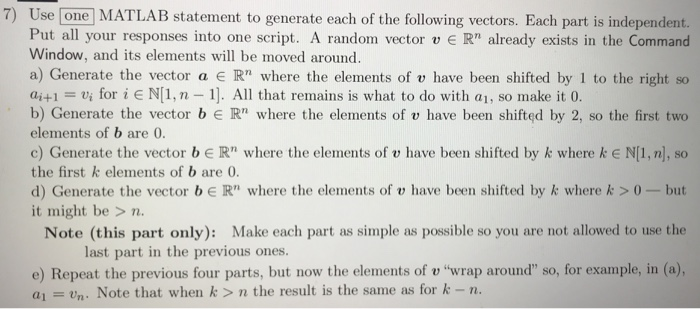7) Use one MATLAB statement to generate each of the following vectors. Each part is independent. Put all your responses into one script. A random vector v ER" already exists in the Command Window, and its elements will be moved around a) Generate the vector a ER" where the elements of v have been shifted by 1 to the right so Q;+1 = vi for i E N[1, n - 1). All that remains is what to do with an, so make it 0. b) Generate the vector ber where the elements of v have been shifted by 2, so the first two elements of b are 0. c) Generate the vector bek" where the elements of v have been shifted by k where ke N[1, n), so the first k elements of b are 0. d) Generate the vector beR" where the elements of v have been shifted by k where k >0 - but it might be > n. Note this part only): Make each part as simple as possible so you are not allowed to use the last part in the previous ones. e) Repeat the previous four parts, but now the elements of v "wrap around" so, for example, in (a), a = Un. Note that when k > n the result is the same as for k-n. 7) Use one MATLAB statement to generate each of the following vectors. Each part is independent. Put all your responses into one script. A random vector v ER" already exists in the Command Window, and its elements will be moved around a) Generate the vector a ER" where the elements of v have been shifted by 1 to the right so Q;+1 = vi for i E N[1, n - 1). All that remains is what to do with an, so make it 0. b) Generate the vector ber where the elements of v have been shifted by 2, so the first two elements of b are 0. c) Generate the vector bek" where the elements of v have been shifted by k where ke N[1, n), so the first k elements of b are 0. d) Generate the vector beR" where the elements of v have been shifted by k where k >0 - but it might be > n. Note this part only): Make each part as simple as possible so you are not allowed to use the last part in the previous ones. e) Repeat the previous four parts, but now the elements of v "wrap around" so, for example, in (a), a = Un. Note that when k > n the result is the same as for k-n







